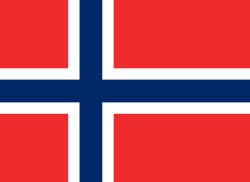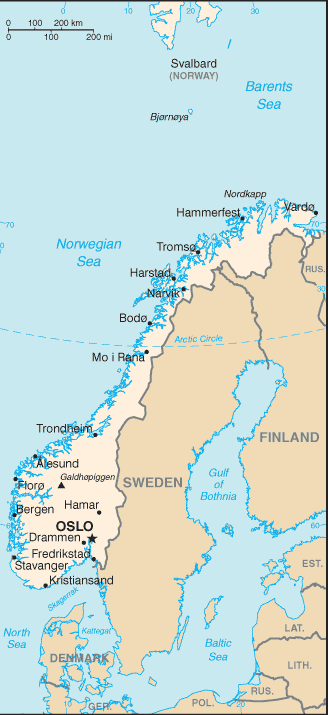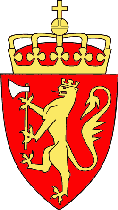Norway
Related Categories:
 Flag of Norway
Flag of NorwayRed with a blue cross outlined in white that extends to the edges of the flag; the vertical part of the cross is shifted to the hoist side in the style of the Dannebrog (Danish flag). |


|
The flag of Norway is red with a blue Scandinavian cross outlined in white that extends to the edges of the flag.
www.nationmaster.com/
Fact Sheet, Flag Pole, Dimensions of the flag, About dimensions in Scandinavian flags.
www.fotw.us/
Since World War II, Norway has changed from being one of the poorest countries in Europe, to one of the wealthiest in the world, with a fully developed welfare system.
en.wikipedia.org/
Ethnically, Norwegians are predominantly Germanic, although in the far north there are communities of Sami who came to the area more than 10,000 years ago, probably from central Asia. In recent years, Norway has become home to increasing numbers of immigrants, foreign workers, and asylum-seekers from various parts of the world. Immigrants now total over 300,000; some have obtained Norwegian citizenship.
Although the Evangelical Lutheran Church is the state church, Norway has complete religious freedom. Education is free through the university level and is compulsory from ages 6 to 16. At least 12 months of military service and training are required of every eligible male. Norway's health system includes free hospital care, physician's compensation, cash benefits during illness and pregnancy, and other medical and dental plans. There is a public pension system.
Norway is in the top rank of nations in the number of books printed per capita, even though Norwegian is one of the world's smallest language groups. Norway's most famous writer is the dramatist Henrik Ibsen. Artists Edvard Munch and Christian Krogh were Ibsen's contemporaries. Munch drew part of his inspiration from Europe and in turn exercised a strong influence on later European expressionists. Sculptor Gustav Vigeland has a permanent exhibition in the Vigeland Sculpture Park in Oslo. Musical development in Norway since Edvard Grieg has followed either native folk themes or, more recently, international trends.
www.state.gov/r/
Introduction
About
Contact
Symbols in The News
Interpret this Symbol
AAC
African
AI
Alchemy
Alphabets
Ancient
Animal Symbolism
Architecture
Art
Articles
Astrology
Baha'i
Blissymbolics
Blueprint Symbols
Buddhist
Celtic Symbols
Cemetery
Chinese Symbols
Christian
Circle
City
Codes
Color
Conlangs
Crop Circles
Danger
Da Vinci Code
Designing Logos
Dictionaries
Dreams
Education
Egyptian Symbols
Electrical
Emoticons
Find Images
Fonts
Food
Fraternity
Hamsa
Healing
Heraldry
Hermetic
Highway Signs
Hindu
History
Hobo
Holiday
Icons
iConji
Islamic
Jain Symbols
Japanese, Kanji
Jewish
Justice
Law
Literary Symbolism
Mandalas
Map
Masonic
Math, Number
Meaning of Names
Medical
Middle East
Military
Miscellaneous
Money
Music
Mythology
Native American
Playing Cards
Power
Psychology
QiQiiKhu
Reiki
Religious
Runes, Norse
Sacred Geometry
Scientific
Science Fiction
Sorority
Sports
Symbols in the News
Tattoos
ThirteenSymbols
Tree of Life
Ursprache
Videos
Visual Languages
Weather
Web Codes
Wicca
Words
Writing Systems
Braille
Coinherence
Coptic
Cuneiform
Easter Island
Etruscan
Happy Human
Hebrew
Kokopelli
Linear B
Lotus
Love Symbols
Mandorla
Moon Alphabet
Nine Pointed Star
Om
Oz
Phonetic
Scarab Beetle
Silent
Theosophy
Unifon
About
Contact
Symbols in The News
Interpret this Symbol
AAC
African
AI
Alchemy
Alphabets
Ancient
Animal Symbolism
Architecture
Art
Articles
Astrology
Baha'i
Blissymbolics
Blueprint Symbols
Buddhist
Celtic Symbols
Cemetery
Chinese Symbols
Christian
Circle
City
Codes
Color
Conlangs
Crop Circles
Danger
Da Vinci Code
Designing Logos
Dictionaries
Dreams
Education
Egyptian Symbols
Electrical
Emoticons
Find Images
Fonts
Food
Fraternity
Hamsa
Healing
Heraldry
Hermetic
Highway Signs
Hindu
History
Hobo
Holiday
Icons
iConji
Islamic
Jain Symbols
Japanese, Kanji
Jewish
Justice
Law
Literary Symbolism
Mandalas
Map
Masonic
Math, Number
Meaning of Names
Medical
Middle East
Military
Miscellaneous
Money
Music
Mythology
Native American
Playing Cards
Power
Psychology
QiQiiKhu
Reiki
Religious
Runes, Norse
Sacred Geometry
Scientific
Science Fiction
Sorority
Sports
Symbols in the News
Tattoos
ThirteenSymbols
Tree of Life
Ursprache
Videos
Visual Languages
Weather
Web Codes
Wicca
Words
Writing Systems
Braille
Coinherence
Coptic
Cuneiform
Easter Island
Etruscan
Happy Human
Hebrew
Kokopelli
Linear B
Lotus
Love Symbols
Mandorla
Moon Alphabet
Nine Pointed Star
Om
Oz
Phonetic
Scarab Beetle
Silent
Theosophy
Unifon
